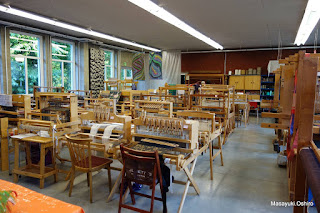Today, I visited Haebaru Ryukyu Kasuri Kaikan
(in English: Ryukyu Ikat Hall)
as they had an open door event
where one could admire fine handwoven 'Ryukyu kasuri' ikat patterns.
I was shocked to hear that these silken weaves (above) were sold for a much lower price than they should normally due to the fact that they contain some (in my eyes) little mistakes.
Some of them are transformed in Western clothes or bags.
They are checked severely by specialists and when they are not perfect,
they are sold at lower prices.
However, these handwoven silken weaves
are beautiful and contain very fine and difficult ikat patterns!






























